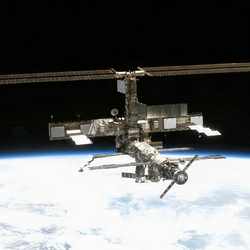
ISS photographed by STS crewmember. Image credit: NASA Click to enlarge
After saying goodbye to the Space Shuttle Discovery’s crew on Saturday, International Space Station (ISS) Commander Sergei Krikalev and NASA Science Officer John Phillips spent much of the week preparing for a spacewalk scheduled for next week.
The six-hour spacewalk begins at 2:55 p.m. EDT, Thursday. Live coverage on NASA TV starts at 1:30 p.m. EDT.
On the spacewalk, the crew will change out a Russian biological experiment, retrieve some radiation sensors, remove a Japanese materials science experiment, photograph a Russian materials experiment, install a TV camera and relocate a grapple fixture.
At 1:44 a.m. EDT, Tuesday, Krikalev’s time spent in space will surpass any other human. Cosmonaut Sergei Avdeyev set the previous record with 748 days in orbit. Krikalev is a veteran of two long-duration flights to the Soviet Union’s Space Station Mir; two flights on the Shuttle; and two flights to the ISS. Krikalev was aboard Mir when the Soviet Union disintegrated; was the first Russian to fly on the Shuttle in 1994; was a member of the Shuttle crew that began assembly of the ISS in 1998; and a member of the first crew to live on board the Station in 2000.
Krikalev and Phillips had an off-duty day on Sunday. On Monday they unpacked and prepared spacewalk tools and the Pirs docking compartment. They will use the Pirs for the spacewalk. During the week, they checked the Russian Orlan spacesuits they will wear and talked with spacewalk experts in the Russian Mission Control Center and in Houston.
On Thursday, the Russian Vozdukh carbon dioxide removal system shut down. The system is one of multiple systems used to scrub the Station cabin air. Flight controllers in Houston activated a U.S. Carbon Dioxide Removal Assembly to perform that function while the Vozdukh is not operating. Russian specialists are analyzing the problem.
Information about crew activities on board the Station, future launch dates, previous status reports and sighting ISS opportunities is available on the Web at: http://www.nasa.gov/station
For information about NASA and other agency programs on the Web, visit: http://www.nasa.gov/home/index.html
Original Source: NASA News Release
